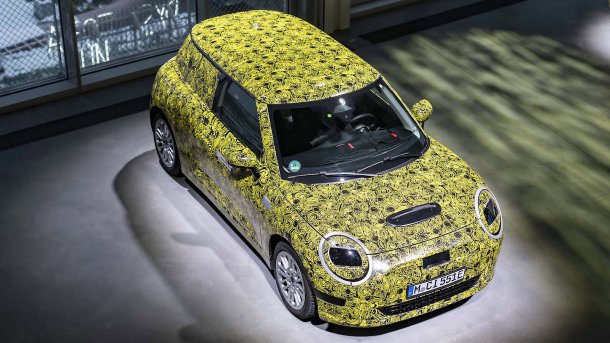Electric cars from Mini: More range and performance announced
The next generation of electric cars from Mini is scheduled to go on sale step by step starting this fall. For customers, this means above all larger batteries

(Bild: BMW)
(Hier finden Sie die deutsche Version des Beitrags)
There have been a few minis with electric drives in the past. The first model in large-scale production appealed to the emotions with its driving performance. Pragmatists criticized above all the price/performance ratio typical of the brand, the short range and the sluggish charging performance. At least on the latter points, the next generation of e-minis is making strong gains. To this end, BMW will collaborate with the Chinese carmaker Great Wall Motor in the future. The first details have now been leaked.
Optionally up to 160 kW in the three-door model
Three models are to be officially unveiled in the next 12 months. The core model remains the just under 3.9 meter long Mini Hatch, which will in future be called the Mini Cooper. It will be available with 135 and 160 kW. The top version will thus be significantly more powerful than the current Mini Electric. A five-door model and a convertible are also firmly planned on this basis. The convertible version of the current Mini is only available as a limited special series for 60,000 euros. You probably have to be very intimately connected to the brand to consider an edition of this dimension. The successor will offer much more in terms of range and charging power and will almost certainly be offered below 60,000 euros.
Mini Aceman
Above the three-door Mini, two SUVs are planned to be marketed as crossovers. The Aceman will be just under 4.1 m long and is only available with front-wheel drive. Its power range will be covered by e-motors that will produce 130 and 160 kW. The Aceman stands for, as Mini brand manager Stefanie Wurst narrows it down, "an electrified go-kart feeling, an immersive digital experience and a strong focus on a minimal environmental footprint."
(Bild: BMW)
Mini Countryman
The Mini Countryman will be significantly larger, entering the league of highly competitive 4.4 m SUVs at around 4.43 m. Almost all well-known mass manufacturers are represented in this segment, so customers have a wide choice. The Countryman will deliver 140 kW as a front-wheel-drive model, while the all-wheel-drive model will come in at 200 kW. Direct competitors will include Smart #1, Volvo XC40, Mercedes EQA and also the BMW iX1.
(Bild: BMW)
Larger battery
Until now, the battery in the electric Mini has been rather slim at 28.9 kWh net (31.6 kWh gross). The real range was almost always significantly less than 200 km. BMW had to up the ante here, although the question is whether the announced 40 to 54 kWh will cover what customers demand in perspective. That may be the case in the three-door Mini Cooper, but many will find it too tight in the Countryman. In a compact SUV, more than 20 kWh/100 km may generally be planned for on the highway even if the driver understands the guideline speed as the upper speed limit. The charging power will be exciting: Until now, the limit was 50 kW. The successor should offer at least twice that at peak.
Package policy
It's still a few months before the new Mini generation is officially unveiled. However, BMW is already revealing a few details. Plug-in hybrids have no future at Mini. A few years ago, the "Rocketman" study caused quite a stir. It was a Mini three-door that had been shortened yet again. This idea is also not being pursued further. With the Mini Electric, the brand tested out whether customers would go along with a package policy that was very expensive for them in individual cases. Extras are now hardly available individually; almost everything is combined in equipment lines.
This can make certain wishes quite expensive. For the manufacturer, such restrictions on freedom of choice bring advantages in the form of inexpensive production - and in the margin, since things are inevitably ordered and paid for that might otherwise not have been ordered. Apparently, the majority of Mini customers go along with this, and so the system will be further expanded in the successor. Leather upholstery for the seats will no longer be available.
(Bild: BMW)
Mini Electric will be more expensive than before
Many months before the actual start of the sale, there are of course still no indications of the prices. However, the prospective buyer can expect continuity here. The small car and its offshoots do not claim to shake up the market with low prices. Currently, the least expensive Mini Electric costs 37,300 euros, more than 40,000 are quickly assembled. BMW continues to hope for a solvent clientele that will then reward a significant increase in range and charging power. So we can expect at least 40,000 euros for the electric three-door and at least 50,000 for the Countryman - in each case without equipment packages. Other brands are responsible for electric mobility that can be afforded by the broad spectrum of society. So far, this has not stood in the way of success: after all, one in five Mini cars is now electric.
(mfz)